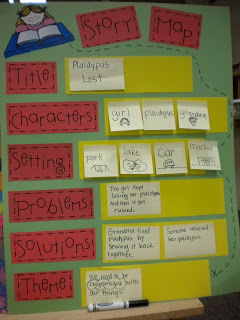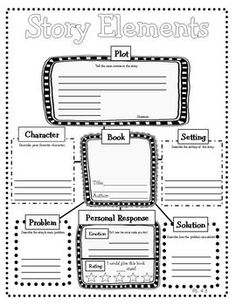What are Story Maps?
A story map is a strategy that uses visual diagrams or graphic organizers to help show students the elements of a story, and is used during or after reading (Reading Rockets, 2015). Students focus on identifying common elements of narrative texts when using these maps, which results in higher literacy comprehension and better understanding of story structure (Jennings, Caldwell, Lerner, 2014). Students can use story maps for short stories or longer novels. Story maps can be organized in a variety of ways, but typically include story characters, setting, problem, and solution (Jennings, Caldwell, Lerner, 2014). Story maps can also include plot and theme. Simple story maps might involve younger students in describing what happens at the beginning, middle, and end of a story. Older students can begin to describe character goals. Students can complete story maps individually, in small groups, or as a whole class. Story mapping can be scaffolded for students of varying reading skill by modeling and discussing each story element as they are written. Story mapping can be differentiated by providing some students with simple story maps and others with complex maps. Prompts for each section can also be beneficial for students.
Visual Representations
|
The image above shows an example of a story map created for the story Plaidypus Lost by Susan Stevens Crummel and Janet Stevens. After completing this story map with students during or after reading, it could be displayed in the classroom as an anchor chart for students.
|
In the video below, a second grade teacher reads aloud The Hen and the Apple Tree, based on the Arnold Lobel fable. Students as a class complete a story map based on the fable (12:05) that includes main characters, setting, beginning, middle, and end, in order to determine the lesson or moral of the story.
|
The image above shows an example of a story map students can complete after reading a particular story. Students could complete this individually, in small groups, or as a class. This graphic organizer includes a "personal response" section that involves students in evaluating and rating the story.
|
Content Area Examples
Reading- Story maps can be used in reading with a variety of texts. After reading, students can practice using story mapping to determine the theme, lesson, or moral of a story. An example of this is shown in the video above. Students can complete a simple story map after reading a short story or novel to practice describing elements and structure of a story. Students can also use story maps to write their own personal narratives or fiction stories.
Math- Students can use story maps in math in order to create their own story or word problems. This helps students who may be struggling in math break down the problem in smaller sections in order to understand what is being asked. Story maps can also be used to assist students in solving open-ended math problems. This might involve students in describing events, the question being asked, and operation to get students thinking about how the problem could be solved.
Social Studies- Students can create their own map of their classroom, school, or playground using a format or diagram similar to that of a story map. Students can also complete a story map based on a historical event. In this case, students might focus on the problem or goal of the event as well as the outcome and theme. This requires students to think about the significance of the particular event.
Science- Students can use story maps as a means of describing an experiment. The story map can be used to describe the materials used to perform the experiment. Students can write the hypotheses being tested in the problem or goal section, and the steps might be included in the plot. When it comes to the theme, students can interpret the results and their meaning in order to make learning connections.
Math- Students can use story maps in math in order to create their own story or word problems. This helps students who may be struggling in math break down the problem in smaller sections in order to understand what is being asked. Story maps can also be used to assist students in solving open-ended math problems. This might involve students in describing events, the question being asked, and operation to get students thinking about how the problem could be solved.
Social Studies- Students can create their own map of their classroom, school, or playground using a format or diagram similar to that of a story map. Students can also complete a story map based on a historical event. In this case, students might focus on the problem or goal of the event as well as the outcome and theme. This requires students to think about the significance of the particular event.
Science- Students can use story maps as a means of describing an experiment. The story map can be used to describe the materials used to perform the experiment. Students can write the hypotheses being tested in the problem or goal section, and the steps might be included in the plot. When it comes to the theme, students can interpret the results and their meaning in order to make learning connections.


